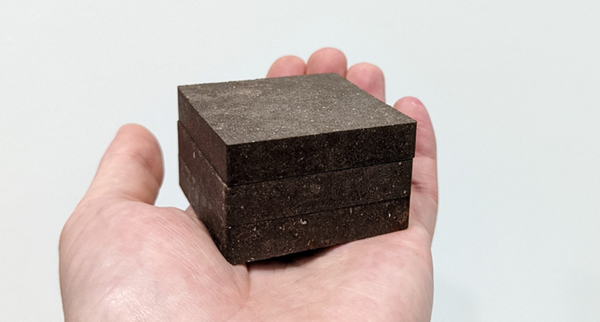
With a sack of potato starch, a large portion of extraterrestrial soil, and just a dash of salt, scientists concocted not a disgusting meal, but a way to create buildings on other worlds. This mixture, known as StarCrete (short for starch-concrete), has been shown to be more than twice as strong as regular concrete.
As detailed in a paper recently published in the journal Open Engineering, a team from the University of Manchester combined potato starch and salt with synthetic martian or lunar regolith. They then mixed it into a gelatin and compressed that to create bricks.
The martian bricks exhibited a compressive strength of 72 Megapascals (MPa), while the lunar bricks were even stronger at nearly 92 MPa. These figures both exceed the compressive strength of ordinary concrete, which is about 32 MPa.
The starch, created from a 55-pound (25 kilogram) sack of dehydrated potatoes, could produce up to 213 bricks — or roughly half a ton. For reference, about 7,500 bricks would be required to build a three-bedroom house, according to a news release. Though, of course, structures built on other worlds would likely be much less spacious.

The best way to build things in space
This experiment came about as part of a scientific movement led by the Future Biomanufacturing Research Hub and other researchers. The goal is to determine the best way to transport building materials to space without issues related to excessive weight or the requirement of too much water or energy once the building materials reach their destination. The primary goal of building these enclosures would be to keep astronauts protected from the harmful radiation and unpredictable, violent weather patterns found on Mars and the lunar surface.
While this may seem like a novel idea, the same group had previously proposed using an astronauts’ blood and urine as possible binding agents for making concrete in space. However, although these binding agents could help create strengthen the mixture, the idea of living in a hut made of bodily fluids was less than appealing — for many reasons.
“Since we will be producing starch as food for astronauts, it made sense to look at that as a binding agent rather than human blood,” said Aled Roberts, a research fellow at the Hub who led the project. “Also, current building technologies still need many years of development and require considerable energy and additional heavy processing equipment, which all adds cost and complexity to a mission. StarCrete doesn’t need any of this and so it simplifies the mission and makes it cheaper and more feasible.
“And anyway, astronauts probably don’t want to be living in houses made from scabs and urine!” added Roberts.
Further testing of the StarCrete will be required before it can be used in a practical capacity. This will include exposing the material to simulated off-world conditions, such as higher radiation, simulated meteor strikes, and extreme temperature fluctuations.
With this breakthrough, researchers believe there’s also the possibility of using other biomaterials as binding agents for martian-based architecture. And because curing StarCrete only requires mild temperatures like those found in your home oven, it could also serve as a greener alternative to using regular concrete here on Earth.









